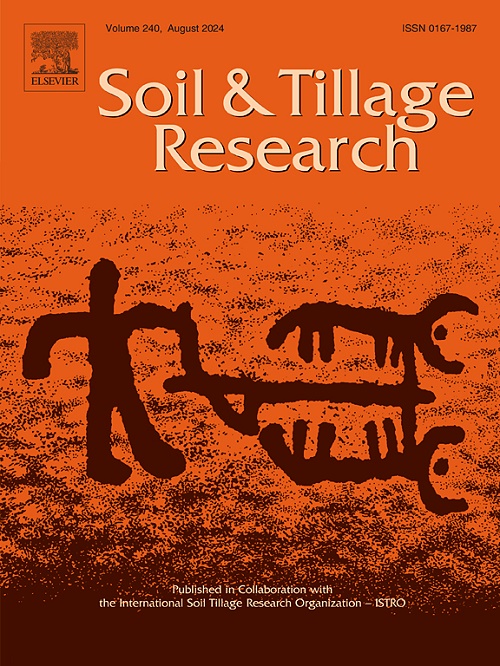水稻-小麦长期种植制度下土壤生物质量评价:连续与剩余有机养分投入的影响
IF 6.8
1区 农林科学
Q1 SOIL SCIENCE
引用次数: 0
摘要
本研究旨在确定亚热带气候条件下水稻+小麦残效(系统I)、小麦+水稻残效(系统II)或水稻+ 小麦(系统III)多年重复有机施肥下土壤质量的关键生物学指标。处理分别为农家肥(FYM)、田菁绿肥(SGM)、SGM+蓝绿藻(BGA)、SGM+FYM、SGM+FYM+ BGA;绿肥(LGLM)、LGLM加固氮菌(AZB)、LGLM+FYM、LGLM+FYM+AZB在小麦中的应用。分析土壤生物特性,包括基础呼吸(BR)、微生物生物量碳(MBC)、微生物代谢商(MMQ)、潜在矿化氮(PMN);土壤酶活性,即脱氢酶(DHA)、双醋酸荧光素(FDA)水解酶、酸性和碱性磷酸酶(AcPA和AlkPA)、芳基硫酸酯酶(ArylSA)活性。主成分分析(PCA)确定了关键指标,即AcPA、MMQ、MBC(系统I)、FDA和MMQ(系统II);BR、DHA、MBC(体系III)。十四年的有机物的应用系统加强了中性粒细胞(43 26 %,%),食品药品管理局(31 %,17 %),AlkPA(8 % 9 %),AcPA(7 %,11 %),ArylSA(36 %,11 %)和雷伊(12 9 %,%)系统I和II,分别。系统ⅲ处理(SGM/LGLM+FYM+ BGA/AZB)触发土壤生物质量指数(SBQI),水稻等效产量(REY)最大。本研究证明,在印度半干旱亚热带地区,施用不同组合的有机肥料可替代小麦,以提高水稻-小麦系统的SBQI和生产力。确定的生物指标可以被验证并用于SBQI的索引,以监测不断变化的有机管理系统下土壤生物健康的时间变化,这一发现可以在印度恒河平原及其周围实施,并在具有类似土壤类型、环境条件和种植制度的南亚和东南亚的更大背景下实施。本文章由计算机程序翻译,如有差异,请以英文原文为准。
Assessment of soil biological quality under long-term rice-wheat cropping system: Effect of continuous vs. residual organic nutrient inputs
The goal of the study was to identify the key biological indicators of soil quality under multiyear of repeated organic manuring in either rice and residual effect in wheat (System I), wheat and residual effect in rice (System II) or both rice + wheat (System III) under subtropical climatic condition. The treatments were farmyard manure (FYM), Sesbania green manure (SGM), SGM with blue green algae (BGA), SGM+FYM, SGM+FYM+ BGA in rice; Leucaena green manure (LGLM), LGLM with Azotobacter (AZB), LGLM+FYM, LGLM+FYM+AZB in wheat. The soil samples were analyzed for soil biological properties such as basal respiration (BR), microbial biomass carbon (MBC), microbial metabolic quotient (MMQ), potential mineralizable nitrogen (PMN); and soil enzymatic activities viz. dehydrogenase (DHA), fluorescein diacetate (FDA) hydrolase, acid and alkaline phosphatases (AcPA and AlkPA), arylsulfatase (ArylSA) activities. Principal Component Analysis (PCA) identified key indicators viz. AcPA, MMQ, MBC (system I), FDA, and MMQ (system II); BR, DHA, MBC (system III). Fourteen years’ application of organics in system III enhanced the PMN (26 %, 43 %), FDA (31 %, 17 %), AlkPA (8 %, 9 %), AcPA (7 %, 11 %), ArylSA (36 %, 11 %) and REY (9 %, 12 %) over the system I and II, respectively. The treatment (SGM/LGLM+FYM+ BGA/AZB) in system III triggered the soil biological quality index (SBQI), and maximized the REY (rice equivalent yield). The study proved that the application of different combination of organic manures in rice, instead of wheat, may be recommended for improvement of both SBQI and productivity of rice-wheat system in semi-arid sub-tropical region of India. The identified biological indicators can be validated and used for indexing the SBQI for monitoring the time-to-time changes in soil biological health under the changing organic management system and this finding can be implemented in and around the Indo-Gangetic plain and in larger context to south and south-east Asia having similar soil type, environmental condition and cropping systems.
求助全文
通过发布文献求助,成功后即可免费获取论文全文。
去求助
来源期刊

Soil & Tillage Research
农林科学-土壤科学
CiteScore
13.00
自引率
6.20%
发文量
266
审稿时长
5 months
期刊介绍:
Soil & Tillage Research examines the physical, chemical and biological changes in the soil caused by tillage and field traffic. Manuscripts will be considered on aspects of soil science, physics, technology, mechanization and applied engineering for a sustainable balance among productivity, environmental quality and profitability. The following are examples of suitable topics within the scope of the journal of Soil and Tillage Research:
The agricultural and biosystems engineering associated with tillage (including no-tillage, reduced-tillage and direct drilling), irrigation and drainage, crops and crop rotations, fertilization, rehabilitation of mine spoils and processes used to modify soils. Soil change effects on establishment and yield of crops, growth of plants and roots, structure and erosion of soil, cycling of carbon and nutrients, greenhouse gas emissions, leaching, runoff and other processes that affect environmental quality. Characterization or modeling of tillage and field traffic responses, soil, climate, or topographic effects, soil deformation processes, tillage tools, traction devices, energy requirements, economics, surface and subsurface water quality effects, tillage effects on weed, pest and disease control, and their interactions.
 求助内容:
求助内容: 应助结果提醒方式:
应助结果提醒方式:


